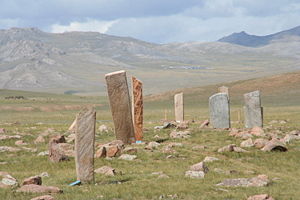- Stag Stones
-
Hirschsteine sind mit Hirschen, Schmuck, Gürteln und Werkzeugen verzierte Steine in der Mongolei und auch Xinjiang (China), die vermutlich etwa 1000. v. Chr. von Nomaden in der Bronzezeit errichtet wurden. Ihren Namen erhielten die Steine von den Darstellungen fliegender Hirsche auf den Steinen.
Bisher wurden 550 dieser Steine, deren historische Bedeutung noch im Dunkeln liegt, entdeckt.
Um weitere Erkenntnisse zu gewinnen, werden im Rahmen des "Mongolian-Smithsionian Deer Stone Project" die Steine durch mongolische Archäologen mit Hilfe von 3D-Scannern untersucht.
Der Tumuluskomplex und die Hirschsteine von Sanhaizi (bzw. Shiebar-kul) (Sanhaizi muzang ji lushi 三海子墓葬及鹿石) im Kreis Qinggil (青河县) in Xinjiang stehen seit 2001 auf der Liste der Denkmäler der Volksrepublik China (5-188).
In Xinjiang sind sie außerdem in Kreis Koktokay, Stadt Altay, Kreis Jeminay, Kreis Zhaosu (Ili), Arixang (Bortala), dem Kreis Jimsar (Changji) und anderen Orten anzutreffen.[1]
Literatur
- A. A. Kovalev: "'Karasuk-Dolche', Hirschsteine und die Nomaden der chinesischen Annalen im Altertum", in: Tian Guangjin und Guo Suxin: Maoqinggou. Ein eisenzeitliches Gräberfeld in der Ordos-Region (Innere Mongolei) (Materialien zur Allgemeinen und Vergleichenden Archäologie (AVA-Materialien) Band 50) Hrsg.: Kommission für Allgemeine und Vergleichende Archäologie des Deutschen Archäologischen Instituts Bonn (KAVA) Beschrieben und kommentiert von Th. O. Höllmann und G. W. Kossack 1992, S. 46-87 .
- Bo Wang, Hirschsteine in Xinjang. Eurasia Antiqua 7, 2001, 105-131.
Weblinks
- The Tumulus and Stag Stones at Shiebar-kul in Xinjiang, China
- Hirschsteine in Xinjiang = Stag Stones in Xinjiang
- Lushi 鹿石 - Chinesisch
Einzelnachweise
Wikimedia Foundation.


